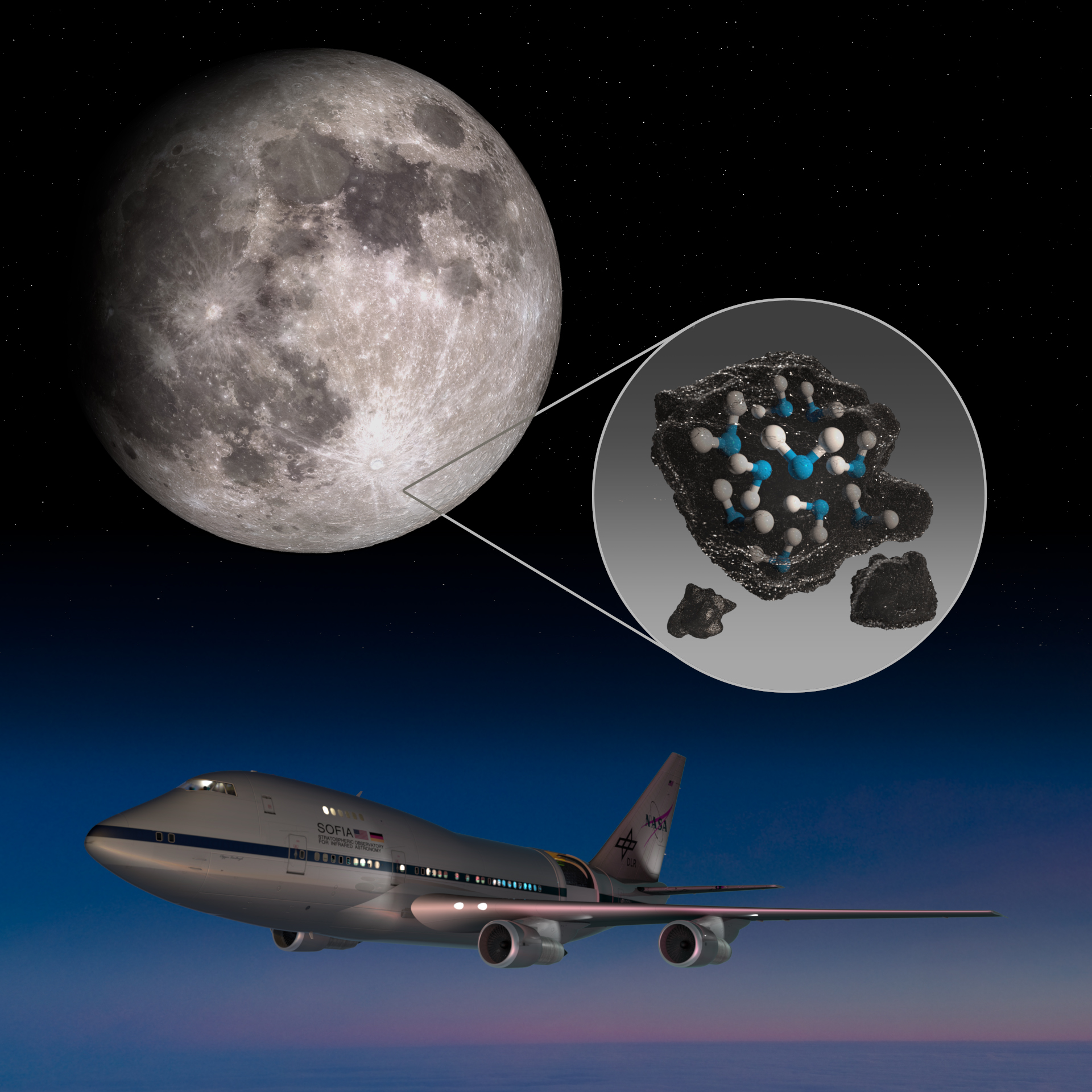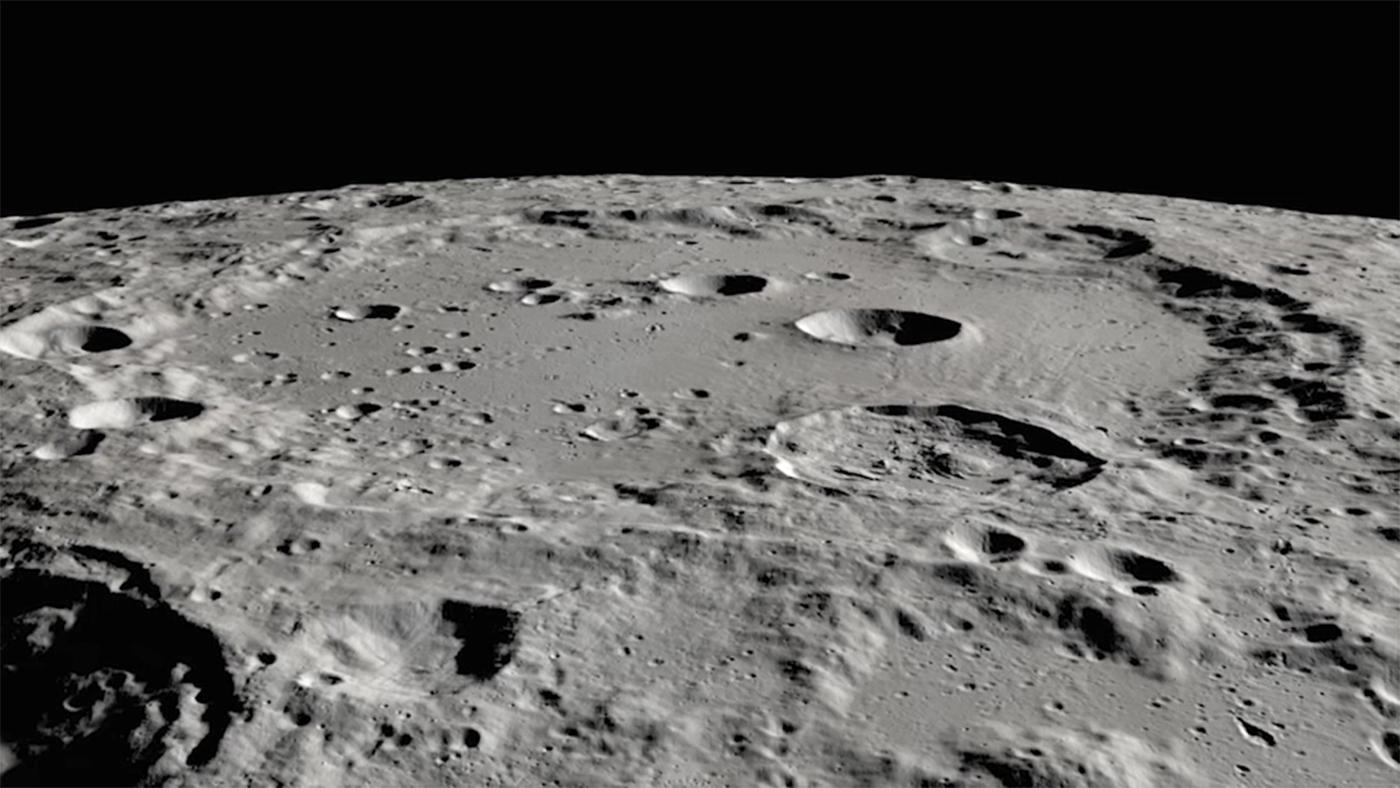
For SpaceUpClose.com & RocketSTEM
CAPE CANAVERAL, FL – Scientists utilizing NASA’s Stratospheric Observatory for Infrared Astronomy (SOFIA) airborne telescope observatory have made the first ever unambiguous discovery of water molecules on the sunlit surface of Earth’s Moon – centered at Clavius crater in the Moon’s southern hemisphere. These results could potentially aid NASA’s Project Artemis plans for human lunar landings.
This discovery indicates that water may be distributed across the lunar surface, and not limited to cold, shadowed places as scientists previously thought.
It had long been thought that water could not survive for long periods on the airless and harsh sunlit lunar surface environment.
NASA scientists announced the discovery at a media briefing Oct 26.
The science results are published also in a paper in the latest issue of Nature Astronomy.
“We had indications that H2O – the familiar water we know – might be present on the sunlit side of the Moon,” said Paul Hertz, director of the Astrophysics Division in the Science Mission Directorate at NASA Headquarters in Washington, at the media briefing.
“Now we know it is there. This discovery challenges our understanding of the lunar surface and raises intriguing questions about resources relevant for deep space exploration.”
“We just announced that – for the first time – we’ve confirmed H2O in sunlit areas of the Moon. This indicates that water might be distributed across the lunar surface,” NASA tweeted.
We just announced that – for the first time – we’ve confirmed H2O💧 in sunlit☀️ areas of the Moon. This indicates that water might be distributed across the lunar surface. https://t.co/Gn0DSu5K95
— NASA Moon (@NASAMoon) October 26, 2020
It could also have very positive implications for NASA Artemis program aimed at landing the first woman and next man at the lunar south pole – at a location where frozen water ice is believed to exist inside permanently shadowed craters.
“NEWS: We confirmed water on the sunlit surface of the Moon for the 1st time using @SOFIAtelescope. We don’t know yet if we can use it as a resource, but learning about water on the Moon is key for our #Artemis exploration plans,” tweeted NASA Administrator Jim Bridenstine.
https://twitter.com/JimBridenstine/status/1320757460269895680
NASA plans to send astronauts back to the Moon under Project Artemis. The first woman and the next man are aiming to land at the lunar south pole on the Artemis 3 mission as soon as 2024.
Permanently shadowed craters at the south pole are believed to hold huge caches of frozen water ice.
NASA’s strategy is eventually to develop a permanent base where astronauts could live off the land by mining water to generate oxygen to breath and rocket fuel.
“Discovery! @SOFIAtelescope operated by @NASA & @DLR_de finds first direct and unambiguous evidence of water molecules on the Moon outside the permanent shadow at the lunar poles,” the German Space Agency DLR tweeted as a SOFIA joint mission partner with NASA.
Discovery! @SOFIAtelescope ✈️ operated by @NASA & @DLR_de finds first direct and unambiguous evidence of water molecules 💧 on the Moon outside the permanent shadow at the lunar poles. 🌔Learn more➡️ https://t.co/Oxx8wpNmXd pic.twitter.com/ajgcR4K8kt
— DLR – English (@DLR_en) October 26, 2020
The water molecules (H2O) were detected in Clavius Crater, one of the largest craters visible from Earth, located in the Moon’s southern hemisphere.
“Previous observations of the Moon’s surface detected some form of hydrogen, but were unable to distinguish between water and its close chemical relative, hydroxyl (OH). Data from this location reveal water in concentrations of 100 to 412 parts per million – roughly equivalent to a 12-ounce bottle of water – trapped in a cubic meter of soil spread across the lunar surface, NASA scientists confirmed.

By comparison the Sahara desert has 100 times the amount of water than what SOFIA detected in the lunar soil.
Thus the discovery raises new questions about how water is created and how it persists on the harsh, airless lunar surface.
The lead scientist on the study says one possibility is the water could potentially by trapped in glass beads in the lunar regolith.
“Without a thick atmosphere, water on the sunlit lunar surface should just be lost to space,” said Casey Honniball, lead author who published the results from her graduate thesis work at the University of Hawaii at Mānoa in Honolulu and who is now a postdoctoral fellow at NASA’s Goddard Space Flight Center in Greenbelt, Maryland. “Yet somehow we’re seeing it. Something is generating the water, and something must be trapping it there.”
Video Caption: Scientists using NASA’s telescope on an airplane, the Stratospheric Observatory for Infrared Astronomy, discovered water on a sunlit surface of the Moon for the first time. SOFIA is a modified Boeing 747SP aircraft that allows astronomers to study the solar system and beyond in ways that are not possible with ground-based telescopes. Molecular water, H2O, was found in Clavius Crater, one of the largest craters visible from Earth in the Moon’s southern hemisphere. This discovery indicates that water may be distributed across the lunar surface, and not limited to cold, shadowed places. Credits: NASA/Ames Research Center
Follow up observations are planned.
NASA describes SOFIA as the world’s largest airborne observatory, SOFIA is a modified 747 that flies high in the atmosphere to provide its nearly 9-foot telescope with a clear view of the universe and objects in our solar system. Flying above 99% of the atmosphere’s obscuring water vapor, SOFIA observes in infrared wavelengths and can detect phenomena impossible to see with visible light.
SOFIA is a joint project between NASA and DLR – the German Space Agency
Watch my commentary about the SOFIA water discovery at WKMG CBS 6 Orlando TV News on Oct 26/27:
Watch Ken’s continuing reports about OSIRIS-REx, Commercial Crew and Artemis and onsite for live reporting of upcoming and recent SpaceX and ULA launches including Demo-2, Starlink, X-37B, Solar Orbiter, Mars 2020 and more at the Kennedy Space Center and Cape Canaveral Space Force Station.
Stay tuned here for Ken’s continuing Earth and Planetary science and human spaceflight news: www.kenkremer.com –www.spaceupclose.com – twitter @ken_kremer – email: ken at kenkremer.com
Dr. Kremer is a research scientist and journalist based in the KSC area, active in outreach and interviewed regularly on TV and radio about space topics.
………….
Ken’s photos are for sale and he is available for lectures and outreach events
Please consider supporting Ken’s work by donating at Patreon:
https://www.patreon.com/kenkremer
x



